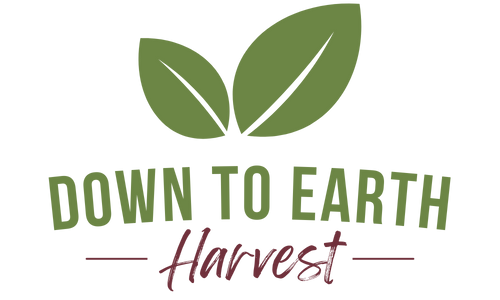
How We Grow
“Feed the soil, that feeds the plants, that feeds the people.” - Farmer Marty
Our practices start with an organic, soil-driven and plant-positive approach. We understand that biologically active and mineralized soils support healthy plants that defend themselves from pest and disease. In turn, healthy plants provide us with nutrient-dense and flavorful vegetables and fruits free from pesticide residues.
Seeds and Starts
We start our own plants from seed, allowing us to control the growing process from the beginning. Most of our seed comes from Johnny’s Selected Seeds, an employee-owned company located in Maine. We choose varieties for their taste and natural pest and disease resistance–that is, a plant's innate ability to use its own immune response to defend itself from bacterial, fungal and viral pathogens without the help of pesticides. Seeds are started in a certified organic, compost-based growing medium from Vermont Compost Company. These inputs, combined with our careful attention, provide us with strong and sturdy transplants that are ready for the field.
Regenerative Practices
In order to maintain healthy and biologically diverse soil, we use minimal soil disturbance (no-till), compost, organic fertilizer, and crop rotation.
We practice minimal soil disturbance to support healthy plant growth. Unlike almost all other vegetable farms–even “organic” or “eco-friendly” ones–we don’t use tillage implements like plows or rototillers. The churning of soil with tillage introduces oxygen deep into the soil, supercharging the bacteria that break down humus (a highly biologically active form of organic matter similar to compost). This gives plants a nutrient boost in the short term, which is one of the reasons farmers do it to “pay the bills.” But over time the constant physical disturbance and loss of organic matter leads to the breakdown of the soil food web–a vast ecosystem of bacteria, fungi, and insects that are mostly invisible to the naked eye. This living web needs to stay intact for soils to store carbon, prevent erosion, and grow healthy vegetables.
We make compost on-site from our own plant residues and locally sourced biomass such as leaves, yard trimmings, and wood chips. Compost feeds the soil organisms that feed and protect the plant, releasing nutrients over time. Well-composted soils also act as a “carbon sink"–by storing carbon in the form of organic matter rather than as the greenhouse gas CO2 in our atmosphere–and as a “sponge” that holds rainwater rather than allowing it to run off the fields and erode the soil.
To give our heavy-feeding plants the extra boost they need to produce a quality crop, we use organic fertilizers from The Fertrell Company in Bainbridge, PA. These fertilizers are composed of naturally-derived materials such as chicken manure, kelp, blood meal, and finely-ground minerals.
Finally, our crop rotation ensures that we don’t grow the same family of vegetables on a particular plot without at least a two-year break in between. This reduces the opportunities for pests or pathogens to accumulate and helps to balance nutrient levels in the soil over time.
Why No-Till?
For the farmer, tillage equipment also helps “pay the bills” by eliminating weeds quickly and providing a blank slate for planting without big investments in manual labor. To accomplish the same labor-saving goals, we use a variety of methods that rely on careful field management and good timing rather than the brute mechanical force of tillage or chemical herbicides. By not tilling, we don’t bring new weed seeds to the soil surface to germinate, which over time reduces weed pressure considerably–as long as we eliminate them before they produce seed! We apply our compost and plant residues only on the soil surface, creating a weed-suppressing mulch, rather than incorporating it deeply with tillage. We also minimize the time between the harvest of one crop and the planting of the next in the same bed (sometimes the entire process takes place on the same day!), which reduces the opportunity for weeds to establish and compete with our crops for nutrients, water, and sunlight. Finally, we use a variety of plastic tarps to eliminate weeds, either by depriving them of the sunlight they need to photosynthesize or raising the surface temperature high enough to “solarize” them before they produce seed.

Pests and Pathogens
Plants with a healthy soil and healthy start don’t require much pest management. We are willing to tolerate a certain level of pest damage before intervening. But when damage begins to reduce product quality we use monitoring, physical barriers, biological insecticides, and predator habitat to deal with pests.
Some pests, such as the cabbage root fly or potato beetle, are best controlled by monitoring their life-cycles and disrupting them with crop rotation and properly timed planting.
Sometimes we use a simple fabric row cover or net to create a physical barrier between the plant and insect pests such as the cucumber beetle or flea beetle.
When these options are not sufficient or impossible to employ, we use only certified-organic biological products. One of our preferred tools are the microbial-based insecticides that specifically target plant-eating insects but do not harm the predatory insects that prey on them. We also prevent insect damage to certain crops with diatomaceous earth–finely ground fossilized seashells that contain microscopically super-sharp points that kill harmful insects upon ingestion. When pest attacks become acute, we use targeted applications of biological materials such as Beauveria bassiana and Bacillus thuringiensis, which bring down insect populations but are harmless for people and animals.
Microbiome Diversity
Bacteria and fungus play an important part of the ecology on our farm. They help to break down organic matter, releasing nutrients for growing crops. Because we want to encourage a healthy biome on our farm, we refrain from using any fungicides or bactericides on plants or soils, even ones that are certified organic. We’d rather encourage a diversity of microbes that compete with each other than try to eliminate them altogether, creating a ‘biological vacuum’ that is susceptible to invasion. When needed, we assist our crops with foliar applications of beneficial bacteria or fungi, as well as mineral solutions to reinforce their natural defenses. To help our plants stay free of bacterial and fungal pathogens we also use management practices that promote optimal airflow and sunlight exposure, such as generous plant spacing and timely pruning.

Knowledge Sharing
Our approach to growing is never static or secret. We are always glad to exchange information with growers of all levels and we are always asking other farmers for their insights. We’ll continue to observe nature and look for insights into ecological management with every task and season.

